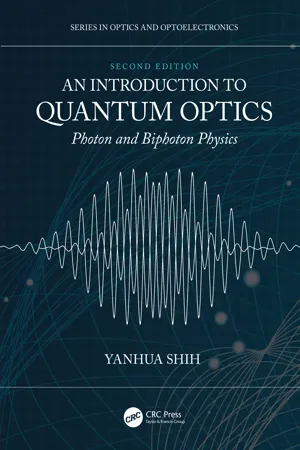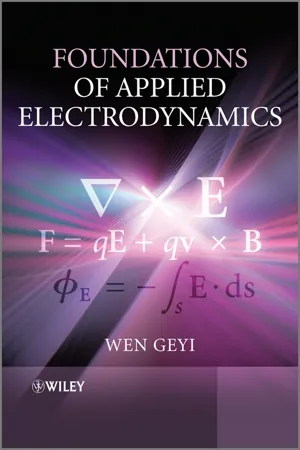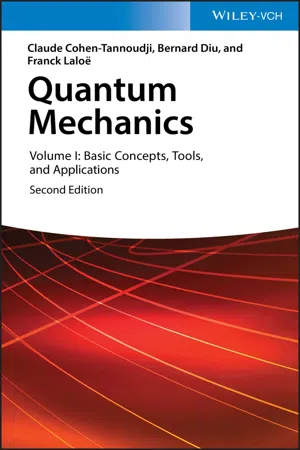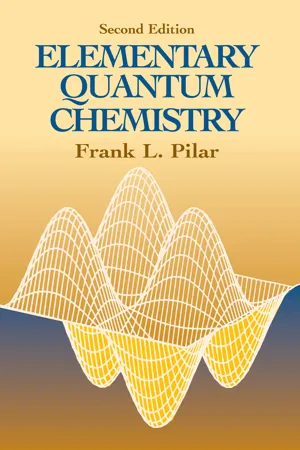Physics
Quantization of Energy
Quantization of energy refers to the concept that energy can only exist in discrete, specific amounts or levels, rather than being continuous. This idea, fundamental to quantum mechanics, was first proposed by Max Planck in 1900. It explains phenomena such as the discrete energy levels of electrons in atoms and the quantized vibrations of atoms in a crystal lattice.
Written by Perlego with AI-assistance
Related key terms
Related key terms
1 of 4
Related key terms
1 of 3
5 Key excerpts on "Quantization of Energy"
- eBook - ePub
An Introduction to Quantum Optics
Photon and Biphoton Physics
- Yanhua Shih(Author)
- 2020(Publication Date)
- CRC Press(Publisher)
ℏω must be carried by the wavefront of the subfield and thus uniformly distributed on the big sphere. Einstein then asked again: suppose that photon is annihilated by a point-like photon counting detector located on the surface of the big sphere, how long does it take for the energy on the other side of the big sphere to arrive at the detector? Two years? Bohr provided a famous answer to this question: the “wavefunction collapses” instantaneously! Why does the wavefunction need to “collapse”? Bohr did not explain. Nevertheless, Bohr has passed an important message to us: quantum mechanical picture of photon is different from Einstein’s granularity, or EM subfield. Although we still have questions regarding the wave-particle duality of a photon, we have to accept the experimental effect that the energy of the electromagnetic field is quantized in nature. We may have to face the truth that a new theory of radiation with quantization is necessary.2.4 FIELD QUANTIZATION AND THE LIGHT QUANTUMIn blackbody radiation, the atoms on the walls of the cavity box continuously radiate electromagnetic waves into the cavity. In general, there are two fundamental principles governing the physical process of the radiation and determining the physical properties of the radiation field. The Schrödinger equation determines the quantized atomic energy level, and the govern the behavior of the radiation field. The interaction between the field and the atom results in a quantized electromagnetic field. The energy and the frequency of the emitted photon are determined by the quantized energy levels of the atom, ℏω = E2 − E1 . On the other hand, any excited electromagnetic field must satisfy the Maxwell equations which determine the harmonic mode structure and the superposition.In the quantum theory of light, the radiation field is treated as a set of harmonic oscillators. The energy of each mode is quantized in a similar way as that of a harmonic oscillator. To quantize the field, we will follow the standard procedure. First, we proceed to link the Hamiltonian of the free electromagnetic field to a set of independent harmonic oscillators. The quantum mechanical results of harmonic oscillators are then adapted to the quantized radiation field. Notice, here, free field means no “sources” or “drains” of the radiation field in the chosen volume of V = L3 that covers the field of interest. The energy of the free field is given byH =(2.4.1)1 2,∫ Vd 3r[]ϵ 0E 2(+r , t)1μ 0B 2(r , t)where V is the total volume of the field of interest. The volume is usually, but not necessarily, treated as a large finite cubic cavity of L - eBook - ePub
- Wen Geyi(Author)
- 2011(Publication Date)
- Wiley(Publisher)
The particle parameters (the energy E and the momentum p of a photon) and the wave parameters (the angular frequency ω = 2π f and wave vector k = u k k with k = 2π/ λ) of a photon are related by Planck-Einstein relations Quantum electrodynamics (QED) deals with the interaction of electromagnetic fields with atoms and molecules. On the atomic and molecular scale, both the particles and fields are subject to quantum conditions. To find the quantized field, the classical Hamiltonian must be converted to quantum mechanical Hamiltonian operator. The classical field variables may be treated as dynamical variables, called canonical coordinates, and their time derivatives are the canonical momenta. The canonical coordinates and canonical momenta are subject to the canonical commutation rules. The field is then converted to an operator through combinations of creation and annihilation operators. This procedure is known as quantization. The QED has been the most precise theory that agrees closely with experiments. The non-relativistic version of QED is also known as quantum optics or cavity QED, which is useful for studying the properties of light and its interaction with materials. The quantization of the field is a very important concept in modern physics. The result from the quantization is the field quanta, which can be created and annihilated. The quanta of the electromagnetic fields are photons, and they are force-carrier particles in electromagnetic interactions. 10.2.1 Quantization in Terms of Plane Wave Functions To overcome the difficulties of normalization, we first assume that the electromagnetic fields are confined in arbitrary volume V. For convenience, we take the volume V as a cube of sides L - eBook - ePub
Quantum Mechanics, Volume 1
Basic Concepts, Tools, and Applications
- Claude Cohen-Tannoudji, Bernard Diu, Franck Laloë(Authors)
- 2020(Publication Date)
- Wiley-VCH(Publisher)
No attempt is made here to be rigorous or complete. The essential goal is to awaken the curiosity of the reader. Phenomena will be described which unsettle ideas as firmly anchored in our intuition as the concept of a trajectory. We want to render the quantum theory “plausible” for the reader by showing simply and qualitatively how it enables us to solve the problems which are encountered on an atomic scale. We shall later return to the various ideas introduced in this chapter and go into further detail, either from the point of view of the mathematical formalism (Chap. II) or from the physical point of view (Chap. III).In the first section (§ A), we introduce the basic quantum ideas (wave-particle duality, the measurement process), relying on well-known optical experiments. Then we show (§ B) how these ideas can be extended to material particles (wave function, Schrödinger equation). We next study in more detail the characteristics of the “wave packet” associated with a particle, and we introduce the Heisenberg relations (§ C). Finally, we discuss some simple examples of typical quantum effects (§ D).A. Electromagnetic waves and photons
A-1. Light quanta and the Planck-Einstein relations
Newton considered light to be a beam of particles, able, for example, to bounce back upon reflection from a mirror. During the first half of the nineteenth century, the wavelike nature of light was demonstrated (interference, diffraction). This later enabled optics to be integrated into electromagnetic theory. In this framework, the speed of light, c, is related to electric and magnetic constants and light polarization phenomena can be interpreted as manifestations of the vectorial character of the electric field.However, the study of blackbody radiation, which electromagnetic theory could not explain, led Planck to suggest the hypothesis of the Quantization of Energy (1900): for an electromagnetic wave of frequency v, the only possible energies are integral multiples of the quantum hv, where h is a new fundamental constant. Generalizing this hypothesis, Einstein proposed a return to the particle theory (1905): light consists of a beam of photons, each possessing an energy hv - eBook - ePub
- Frank L. Pilar(Author)
- 2013(Publication Date)
- Dover Publications(Publisher)
CHAPTER 3 THE QUANTUM MECHANICS OF SOME SIMPLE SYSTEMSBeginning students often find it difficult to assimilate new abstract concepts when they are presented in an equally unfamiliar mathematical formalism; the struggle to master the physics as well as the mathematics simultaneously can be formidable. In the present chapter we will consider some of the most important concepts and results of quantum mechanics—all within the framework of relatively simple mathematics. Later, when we encounter some of these same concepts in more mathematically complex systems, we can draw simple analogies to these simpler systems to facilitate understanding.Since we will frequently need to consider the transition of a system from one stationary state to another (a time-dependent process), the first section is a brief digression into some elementary aspects of such transitions. In particular, we will consider the mechanism by which atoms and molecules interact with electromagnetic radiation and the rules which determine which quantum states participate in the interaction.3-1 INTERACTION OF MATTER AND RADIATIONFigure 3-1 represents an energy-level diagram of a system which can exist in a number of different stationary quantum states. Three of these states are given the labels k, l, and m, and the corresponding energies are arbitrarily ordered Ek ≤El ,≤Em . The fundamental relationships governing transitions between these states were first developed by Einstein.1FIGURE 3-1Energy-level diagram for a system showing absorption and emission processes from the state l to upper and lower states m and k, respectively.Consider a collection of a large number of initially identical systems, e.g., individual atoms or molecules. Each system is assumed to be capable of acquiring energy from an external electromagnetic field so as to pass to a higher energy state, or, alternatively, of emitting energy as electromagnetic radiation so as to pass to a lower energy state. In the emission process, the frequency of the emitted radiation involving states l and k - 19 However, one of its implications remains today: the existence of zero-point energy. Quantum objects and processes possess a non-zero average rest energy even at absolute zero temperature.In any case, despite the apparent triumph of deriving the radiation law that bears his name, Planck regarded the constants k and h appearing in the law as of far greater significance. First of all, the values he gave them are remarkably accurate, within a few percent of their current values. But more importantly, Planck showed that they could be combined, together with Newton’s gravitational constant G, and c the speed of light in vacuo, to form a system of units of length and time that were completely “natural” in that they contain no reference to human measures. By multiplying and dividing different combinations of G, c, k, and h, one obtains what is now called the Planck time (5.39106 × 10−44 seconds) and the Planck length (1.616199 × 10−35 m), the tiny scale that current theory regards as the domain of quantum gravity. The same absolute measures could be found by any careful investigators anywhere in the universe, and in this sense are completely non-anthropomorphic. Planck’s striving for the absolute, though it didn’t work with the second law, paid off here in spades in giving rise to the ideal of a completely de-anthropomorphized physics of law and of fundamental natural units. This would be a unifying theme of Planck’s philosophy of science for the rest of his life.In 1918, the last year of the Great War, the Nobel Prize in physics was awarded to Planck for “the advancement of Physics by his discovery of energy quanta”. In his Nobel address in June 1920, Planck modestly recalled his reluctance to accept the physical reality of the energy quantum. After all, it could be interpreted in two ways, first as just a “fictional quantity” in which case “the whole deduction of the radiation law was in the main illusory and represented nothing more than an empty non-significant play on formulae”. Or, secondly, one could regard “the derivation of the radiation law as based on a sound physical conception”. Planck continued:
Index pages curate the most relevant extracts from our library of academic textbooks. They’ve been created using an in-house natural language model (NLM), each adding context and meaning to key research topics.
Explore more topic indexes
Explore more topic indexes
1 of 6
Explore more topic indexes
1 of 4




